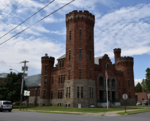Prescott, Ontario

Prescott is a town on the north shore of the Saint Lawrence River in province of Ontario, Canada. The town is a part of the United Counties of Leeds and Grenville. In 2021, it had a population of 4,078. The Ogdensburg–Prescott International Bridge, 5 kilometres (3.1 mi) east of Prescott at Johnstown, crosses the Canada–United States border and connects the town with the city of Ogdensburg, New York. Prescott was founded in the early 19th century by Edward Jessup, a Loyalist soldier during the American Revolution, who named the village after a former Governor-in-Chief, Robert Prescott. Before 1834, the town was a part of Augusta township; however, in that year the town became a police village and severed its ties with Augusta. The land here was ideal for settlement during the 18th and 19th centuries as it was situated between Montreal and Kingston along the St. Lawrence River at the head of the rapids.
Excerpt from the Wikipedia article Prescott, Ontario (License: CC BY-SA 3.0, Authors, Images).Prescott, Ontario
Claxton Terrace,
Geographical coordinates (GPS) Address Nearby Places Show on map
Geographical coordinates (GPS)
| Latitude | Longitude |
|---|---|
| N 44.716666666667 ° | E -75.516666666667 ° |
Address
Claxton Terrace
K0E 1T0
Ontario, Canada
Open on Google Maps









